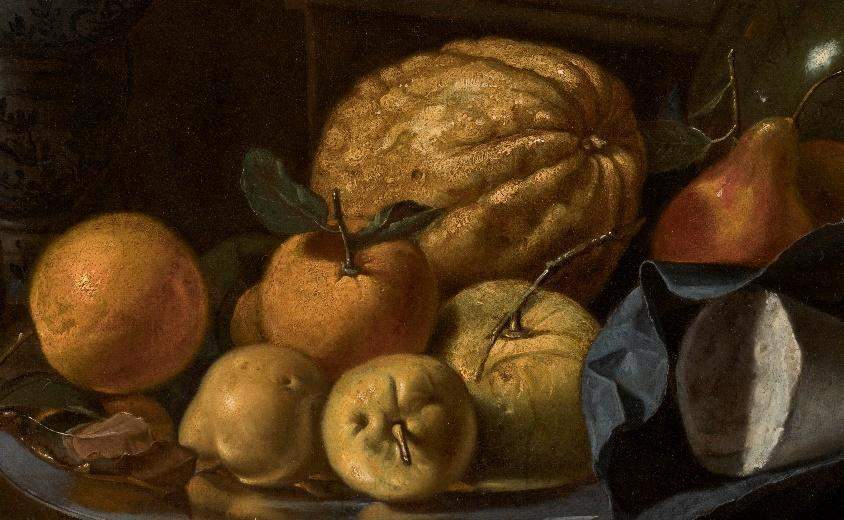Credem, one of Italy’s leading banking institutions, announces the acquisition of a work by Cristoforo Munari (Reggio Emilia, 1667 - Pisa, 1720), which will be presented to the public for the first time on Saturday, Oct. 1, when, from 9 a.m. to 6 p.m., the bank will open its headquarters at Palazzo Spalletti Trivelli on Via Emilia San Pietro 4 in Reggio Emilia as part of the Italian Banking Association’s (ABI) Invito a Palazzo initiative , which the bank has joined for the 21st consecutive year. The initiative aims to allow the public to visit free of charge, throughout Italy, palaces and art collections owned by banks.
The work will be presented at the opening of the exhibition La gioia della materia bella, which will display two still lif es by Munari in one of the rooms on the ground floor of Palazzo Spalletti Trivelli. The new acquisition, which became part of Credem’s collection in 2020, is a work depicting fruit, precious Chinese porcelain and crystal, executed by the Reggio Emilia painter around 1700, during his stay in Rome.
Cristoforo Munari enjoyed considerable success during his lifetime, moving to Rome in the late 17th century and in 1707 to Florence, where Grand Prince Ferdinando de’ Medici, a refined collector and still life enthusiast, offered him his protection. Munari was particularly adept at accurately and vividly rendering the surface of objects, from elegant Chinese porcelain to fruit peels, now smooth now wrinkled, to the most refined crystals. The painter’s extraordinary sensitivity to matter had made him famous in his lifetime and continues to amaze even today those who pause to admire his creations. The works on display in the exhibition are representative of Munari’s two specialties, the “aristocratic” still life and the “rustic kitchen.” By deploying these different registers, the master was able to satisfy the taste of his patrons, who loved to contemplate both refined compositions of fruit, crystal, musical instruments and precious porcelain, as well as representations more closely related to the domestic and everyday reality of the products of nature, animal and vegetable.
“I am particularly happy that the headquarters of our bank can finally return to host all the citizens who are passionate about art and culture, who will be able to admire a new work that has become part of the institution’s collection,” said Lucio Igino Zanon di Valgiurata, Credem Chairman. “In the past two years, despite the serious health difficulties that have affected all of us, we have continued to believe in the social value of this initiative by organizing virtual tours that have attracted much interest. Palazzo Spalletti Trivelli, however, is the beating heart of the bank and being able to enjoy live the treasures it holds is an irreplaceable experience that we want to continue to offer the public.”
The exhibition will remain open until Jan. 6, 2023, Monday through Friday, 8:20 a.m. to 1:20 p.m. and 2:45 to 4 p.m. It will be mandatory to book the visit online at the link https://prenota-evento.credem.it/. Guests will be divided into groups of up to 20 people and the use of a surgical mask will be required. The visit to the exhibition and the institute’s art collections will be accompanied by commentary by Flavio Boccazzi, Antonio Brighi, Alessandra Carrara, Margherita Casini, Odette D’Albo, Aurora Marzi, Elisabetta Del Monte, Costanza Montagna, Lucrezia Pezzarossa, Amalia Salsi, and Alessandra Tellurio.
The halls of the ancient aristocratic palace, which belonged to the Guicciardi counts in the late 17th century and, starting in 1830, to the Spalletti Trivelli counts, are decorated in neoclassical taste with numerous scenes from Greek and Roman mythology. Remarkable, in addition to the grandiose ten-meter-high ballroom, are the rooms completely decorated in trompe-l’oeil style with sumptuous curtains and allegorical overlays dedicated to music, astronomy, literature, agriculture, and hunting. The palace now houses two collections; the first is a collection of oriental art, with artifacts from China, India, Cambodia, Burma, Mongolia, and Japan. The objects housed in the cases date from 2000 B.C. to the 19th century, such as porcelain vases, gilded bronzes, cloisonné enamels and terracotta statues. The second is a collection of ancient paintings from the 16th, 17th and 18th centuries, in which paintings by the most important artists active in Reggio and Emilia can be seen, with masterpieces by, among others, Francesco Francia, Lorenzo Costa, Denis Calvaert, Guido Reni, Guercino, Camillo Procaccini, Alessandro Tiarini, Giovanni Lanfranco, Luca da Reggio, Leonello Spada, Giuseppe Maria Crespi and Felice Boselli. Finally, in the basement are the ruins of the Roman Forum area of ancient Regium Lepidi, dating from the 2nd century BC. C. to the 4th century A.D., which constitute the only archaeological site currently accessible in Reggio Emilia. In fact, the remains of a large public building, the Basilica, and another imposing construction, probably corresponding to the city temple, are visible.
Pictured is a detail of Munari’s newly acquired work.
 |
| Credem bank shows for the first time a newly acquired Still Life by Cristoforo Munari |
Warning: the translation into English of the original Italian article was created using automatic tools. We undertake to review all articles, but we do not guarantee the total absence of inaccuracies in the translation due to the program. You can find the original by clicking on the ITA button. If you find any mistake,please contact us.